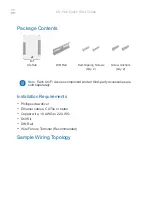
16
When the Default settings are not suitable for your application,
the CN9000A can be tuned for optimum performance by the
adjustment of control Parameters. Section 5 will provide the
guidance needed to establish the appropriate settings.
Alternatively, the Autotune Option can be used to enable the
controllers microprocessor to attempt to calculate the optimum PID
Parameters. If you wish to use the Autotune Option, go to Section
5.1.2 and run Autotune AT.
The Default Range will limit the setpoint values. However, should a
particular application require the use of additional controller
features, for example: second setpoint output or tenth degree
resolution, refer to Section 3.5, Parameter Adjustments. The
instrument will indicate process temperatures over the full
linearized range shown in Table 3-4, Function .16. The Default
setpoint full scale (automatically selected by choice of sensor) may
be altered to any value within the linearized band (Table 3-4,
Function .16) by using the following procedure to adjust Function
.24. (Refer to Section 3.5 for more details on adjusting Functions).
Steps 1 through 6 are used to change the upper limit of the
setpoint range. Steps 7 through 10 are used to change the actual
setpoint and check the value.
Ensure that the setpoint range maximum is
compatible with safety requirements.
3.4.2
Changing the Allowable Setpoint Default
Range (Function .24)
CAUTION
Press the P button (use blunt tool since the P key is a
recessed button). The display shows "0.
0
" with the right most
digit (function number) flashing.
Press
24 times (or until the CN9000A displays "- -
24
" with
"
24
" flashing).
Press
★
to display the maximum allowable setpoint (for
example, "
400
" with "
400
" flashing).
1.
2.
3.
WW
W.100
Y.COM.TW
WW
W.100
Y.COM.TW
WW
W.100
Y.COM.TW
WW
W.100
Y.COM.TW
WW
W.100
Y.COM.TW
WW
W.100
Y.COM.TW
WW
W.100
Y.COM.TW
WW
W.100
Y.COM.TW
WW
W.100
Y.COM.TW
WW
W.100
Y.COM.TW
WW
W.100
Y.COM.TW
WW
W.100
Y.COM.TW
WW
W.100
Y.COM.TW
WW
W.100
Y.COM.TW
WW
W.100
Y.COM.TW
WW
W.100
Y.COM.TW
WW
W.100
Y.COM.TW
WW
W.100
Y.COM.TW
WW
W.100
Y.COM.TW
WW
W.100
Y.COM.TW
WW
W.100
Y.COM.TW
WW
W.100
Y.COM.TW
WW
W.100
Y.COM.TW
WW
W.100
Y.COM.TW
WW
W.100
Y.COM.TW
WW
W.100
Y.COM.TW
WW
W.100
Y.COM.TW
WW
W.100
Y.COM.TW
WW
W.100
Y.COM.TW
WW
W.100
Y.COM.TW
WW
W.100
Y.COM.TW
WW
W.100
Y.COM.TW
WW
W.100
Y.COM.TW
WW
W.100
Y.COM.TW
WW
W.100
Y.COM.TW
WW
W.100
Y.COM.TW
WW
W.100
Y.COM.TW
WW
W.100
Y.COM.TW
WW
W.100
Y.COM.TW
WW
W.100
Y.COM.TW
WW
W.100
Y.COM.TW
WW
W.100
Y.COM.TW
WW
W.100
Y.COM.TW
WW
W.100
Y.COM.TW
WW
W.100
Y.COM.TW
WW
W.100
Y.COM.TW
WW
W.100
Y.COM.TW
WW
W.100
Y.COM.TW
WW
W.100
Y.COM.TW
WW
W.100
Y.COM.TW
WW
W.100
Y.COM.TW
WW
W.100
Y.COM.TW
WW
W.100
Y.COM.TW
WW
W.100
Y.COM.TW
WW
W.100
Y.COM.TW
WW
W.100
Y.COM.TW
WW
W.100
Y.COM.TW
WW
W.100
Y.COM.TW
WW
W.100
Y.COM.TW
WW
W.100
Y.COM.TW
WW
W.100
Y.COM.TW
WW
W.100
Y.COM.TW
WW
W.100
Y.COM.TW
WW
W.100
Y.COM.TW
WW
W.100
Y.COM.TW
WW
W.100
Y.COM.TW
WW
W.100
Y.COM.TW
WW
W.100
Y.COM.TW
WW
W.100
Y.COM.TW
WW
W.100
Y.COM.TW
WW
W.100
Y.COM.TW
WW
W.100
Y.COM.TW
WW
W.100
Y.COM.TW
WW
W.100
Y.COM.TW
WW
W.100
Y.COM.TW
WW
W.100
Y.COM.TW
WW
W.100
Y.COM.TW
WW
W.100
Y.COM.TW
WW
W.100
Y.COM.TW
WW
W.100
Y.COM.TW
WW
W.100
Y.COM.TW
WW
W.100
Y.COM.TW
WW
W.100
Y.COM.TW
WW
W.100
Y.COM.TW
WW
W.100
Y.COM.TW
WW
W.100
Y.COM.TW
WW
W.100
Y.COM.TW
WW
W.100
Y.COM.TW
WW
W.100
Y.COM.TW
WW
W.100
Y.COM.TW
WW
W.100
Y.COM.TW
WW
W.100
Y.COM.TW
WW
W.100
Y.COM.TW
WW
W.100
Y.COM.TW
WW
W.100
Y.COM.TW
WW
W.100
Y.COM.TW
WW
W.100
Y.COM.TW
WW
W.100
Y.COM.TW
WW
W.100
Y.COM.TW
WW
W.100
Y.COM.TW
WW
W.100
Y.COM.TW
WW
W.100
Y.COM.TW
WW
W.100
Y.COM.TW
WW
W.100
Y.COM.TW
WW
W.100
Y.COM.TW
WW
W.100
Y.COM.TW
WW
W.100
Y.COM.TW
WW
W.100
Y.COM.TW
WW
W.100
Y.COM.TW
WW
W.100
Y.COM.TW
WW
W.100
Y.COM.TW
WW
W.100
Y.COM.TW
WW
W.100
Y.COM.TW
WW
W.100
Y.COM.TW
















































